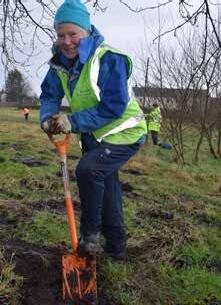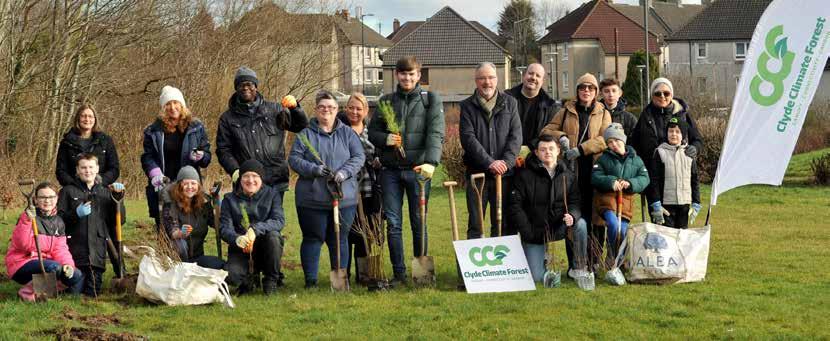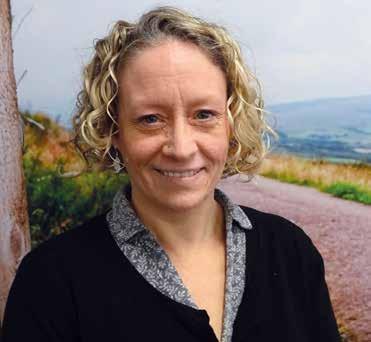CLYDE CLIMATE FOREST
3 Year Review
2021-2024

18 million trees over the next decade


3 Year Review
2021-2024

18 million trees over the next decade


The Clyde Climate Forest (CCF) was launched by the Glasgow City Region (GCR) Cabinet in June 2021 with a headline target of “18 million trees over the next decade”. That roughly equates to 10 trees for every person living in the 8 local authorities that make up Glasgow City Region.
The CCF target aligns with the Scottish Government’s ambition as set out in the Climate Change Plan to increase woodland cover across Scotland.
Trees, woodlands, and forests provide a nature-based solution to the twin challenges of the climate and ecological emergencies. They provide urban cooling in heatwaves, assist in managing surface water and slowing runoff, and are also effective carbon sinks. They provide essential ecosystem services and habitats and, when part of a wider network, they facilitate species migration as the climate warms.

Specific objectives for the Clyde Climate Forest are based on the three ‘C’s’:
Canopy new urban tree planting in “target neighbourhoods” with local communities.
Connectivity targeted tree planting to protect biodiversity, and offer migratory routes between the north and south as the climate changes.
Carbon large scale plantation forests will be supported in line with the region’s existing Forest & Woodland Strategy.
10,000 3.5 MILLION
TREES COMMUNITY
PLANTED
27
“New community woodlands, trees and forests will bring multiple benefits to our local communities as well as wildlife.
The pandemic has brought into focus like never before the value of local spaces as places to exercise, de-stress and engage with nature and this project can help to deliver the Green Recovery. The economic, ecological and social benefits will be extensive.’’
Councillor Aitken Chair of Glasgow City Region Cabinet



To date, there has been engagement in 12 of the 16 CCF “target neighbourhoods” deemed vulnerable to climate impacts, helping to embed the CCF vision into the heart of local communities.

“Trees
clean the air, filter noise and pollution, reduce flooding, and provide a calming environment in which people can relax and socialise. What’s not to like?”
Cathy McVean (74) Volunteer

The CCF team has run 27 planting events, working with 11 schools and 20 community groups to provide a hands-on experience for supporters of the initiative.
“Getting kids outdoors planting trees educates them on the importance of trees and what they do for us and the wider environment. Kids understand about climate change and want an opportunity to do something valuable, the CCF offers that and it’s just brilliant.”

Cllr Steel, Education Convenor West Dunbartonshire Council
The CCF executive team work collaboratively with others, including local authorities and the GCV Green Network to ensure a strategic, joined up and well-considered approach to identifying each proposed planting site.
The aim is to maximise impact across policy goals including health and wellbeing, biodiversity enhancement, climate mitigation and of course the drive to Net Zero.




Over the first three years of the initiative over 10,000 trees have been planted across the Target Neighbourhoods of Glasgow City Region.
Progress across the three ‘C’s’ has been variable over the last three years. In the first year of the initiative, the team were focused on developing the Canopy (target neighbourhood) and Connectivity strands in anticipation of future planting. Meanwhile tree numbers planted under the Carbon strand were good.
In the second year, the team planted trees in 5 of the Target Neighbourhoods, although overall tree numbers were down due to storm damage and low Forestry Grant Scheme uptake. Over the last year, 2023/2024, there has been planting in 11 of the 16 Target Neighbourhoods and tree numbers across the board have increased, with this being our best year so far for Target Neighbourhood engagement.
Around 18 million trees will be planted in both urban and rural parts of Glasgow City Region over the next decade.

Following an assessment of migratory routes, over 200 areas of priority habitat ‘connectivity’ sites were identified to aid the movement of species from the Southern Uplands to the Loch Lomond and Trossachs National Park.
These native woodland target areas are supported by Forestry Grant Scheme funding and higher payment rates.
The CCF executive team has contacted all of the landowners within these areas to encourage woodland creation. Five Local Authority Assessments have been completed, with 3 more to follow in the coming year.
These assessments help identify woodland creation opportunities on local authority owned land and we are looking at these to develop a programme of planting over the coming years.




Sixteen ‘Target Neighbourhoods’ have been identified across urban areas of the region, with at least one in each Local Authority area.
These are the focus for urban tree planting activities for the CCF executive team. Target Neighbourhoods are characterised by having low levels of urban trees and high vulnerability to the impacts of climate change. We have been working with Local Authorities to deliver planting in 12 Target Neighbourhoods to date (Bellshill, North Motherwell, Burnbank, Rutherglen,
All trees absorb carbon, and so all our tree planting helps address this delivery objective.
Larger planting areas, generally on the hill ground across the region, are mostly supported by the Forestry Grant Scheme.
Large scale tree planting can be affected by outside influences such as investment markets or by diverting forestry resources to storm events. Planting related to this ‘C’ has fluctuated over the last three years, with hectares planted per year ranging from 70 to 800.
Blantyre, Central Greenock, Possilpark, Levern & District, Bishopbriggs, Barrhead, Foxbar & Brediland, and Clydebank East) with some locations having more than one year of tree planting.
These projects received funding from the Woodland Trust, Trees for Cities, The Conservation Volunteers, Arbor Day Foundation and sponsorship from local businesses. GCR member authorities also delivered their own CCF tree planting projects, with CCF partners and independently. The planning and delivery of these projects is a great example of collaboration between CCF delivery partners, the 8 Local Authorities and local communities.



We face the same fundamental challenges that all tree planting has, land availability and the funds and resources to undertake the work.
To help address this, we’ve commissioned 8 Local Authority Assessments across the region to identify and recommend priority tree planting locations on council landholdings, with five now complete and three due for completion later this year.
We’re providing the skills, resources and expertise to help councils assess sites and access funding to help deliver tree planting and community events on the ground.
Funding continues to be a major issue. This has been a mounting challenge each year. We will continue to explore new funding opportunities, but securing a longer term commitment to core funding would allow the team to focus more on delivering the benefits of CCF across the region.

Another issue we face is getting the right tree in the right place and then ensuring the establishment of that tree. Sometimes young trees and their shelters are subjected to vandalism which can be costly. We are working with schools and communities to help plant


and care for the trees. This year we have introduced a Community Volunteer Coordinator who will be responsible for recruiting and managing volunteers as part of the Clyde Climate Forest Tree Warden Network, with support and guidance from The Tree Council who lead on the national Tree Warden Scheme.
Although we have managed to find some solutions, we continue to need your support, advocacy and financial contributions where possible to make our goal of planting 18 million trees a reality.
Chris Stark









